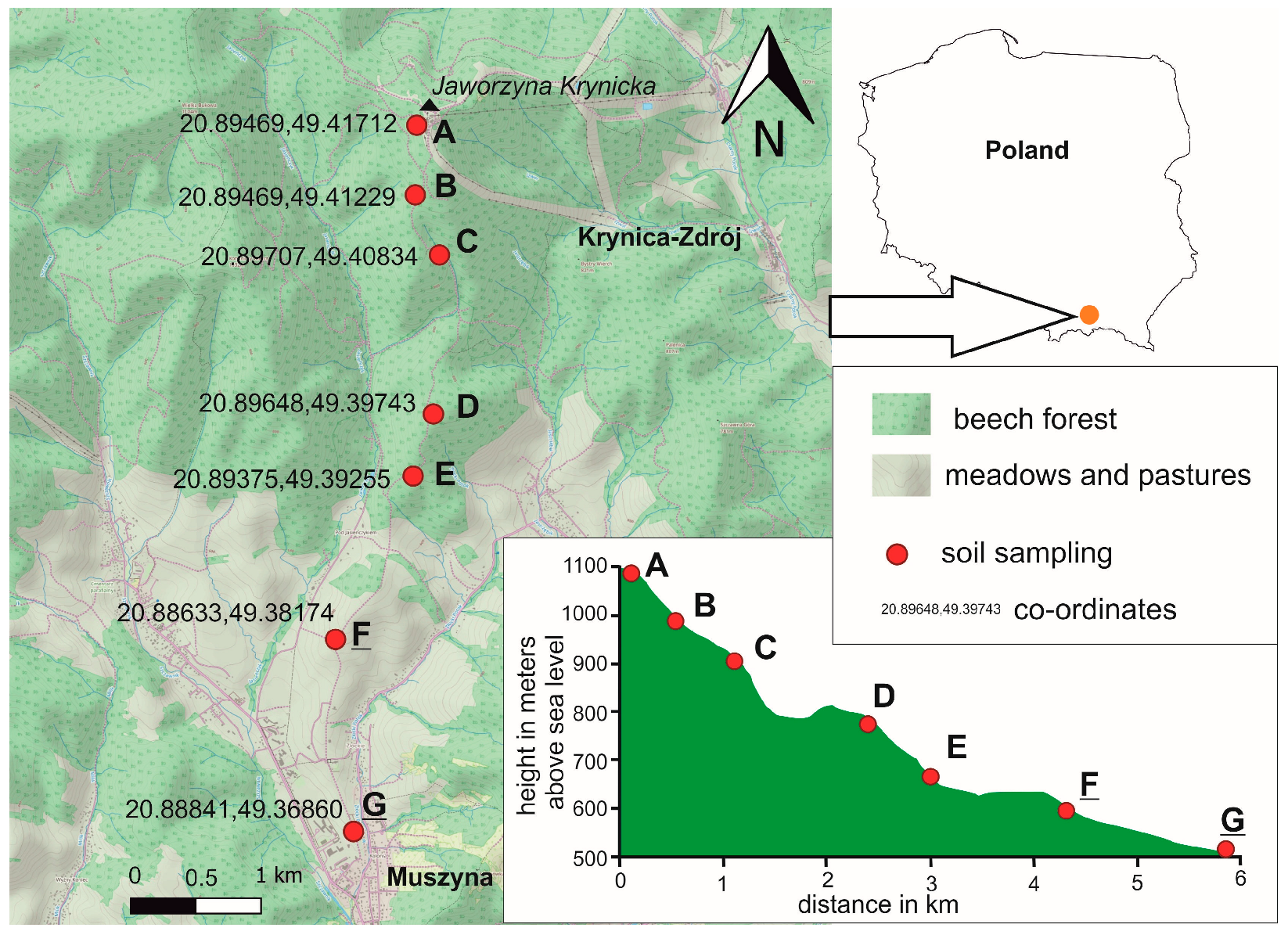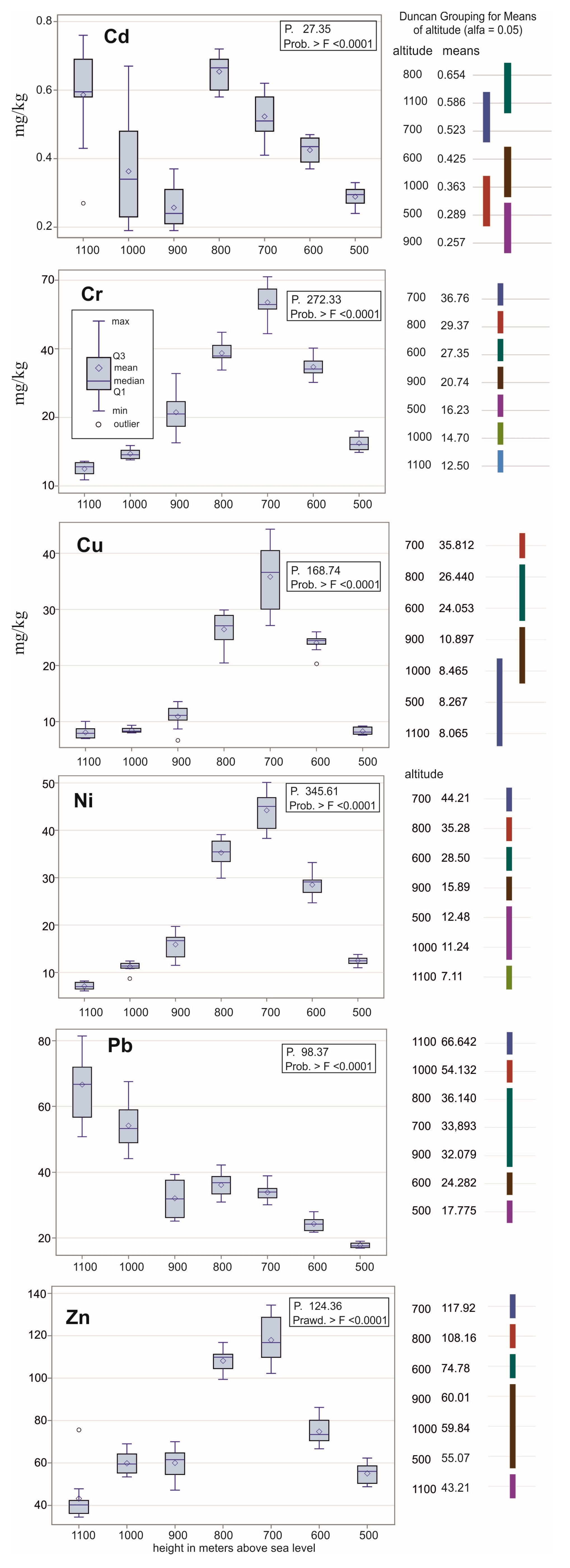Soil Contamination with Metals in Mountainous: A Case Study of Jaworzyna Krynicka in the Beskidy Mountains (Poland)
Abstract
1. Introduction
2. Materials and Methods
2.1. Study Area
2.2. Sampling
2.3. Chemical Analysis
- Manually cleaning the collected samples by removing foreign material (dry leaves, twigs, grass, etc.);
- Drying the samples at 100 °C;
- Grinding soil samples in a ceramic mortar and sieving through a sieve with a mesh diameter of 2 mm;
- Mineralization, which is performed to completely break down soil samples into simple, solid compounds—1 g of the dried sample material was digested with a modified Aqua Regia solution of equal parts concentrated HCl, HNO3, and DIH2O for one hour in a heating block or hot water bath. The resulting solution was filtered and stored in sealed polyethylene containers until sent for spectrometric analysis;
- Determination of the pseudo-total content of heavy metals using the inductively coupled plasma mass spectrometry (ICP-MS) method in the Bureau Veritas Commodities, Vancouver BC, Canada. The use of the Bureau Veritas methodology made it possible to accurately determine the metal content in the soil material, with the following detection limits (mg/kg) for Cd: 0.01, Cr: 0.5, Cu: 0.01, Ni: 0.1, Pb: 0.01, and Zn: 0.1. The STD DS11 and STD OREAS262 standards were used as reference materials.
2.4. Statistical Analysis of the Data
3. Results
4. Discussion
5. Conclusions
Author Contributions
Funding
Institutional Review Board Statement
Informed Consent Statement
Data Availability Statement
Conflicts of Interest
References
- Nguyen, H.T.H.; Nguyen, B.Q.; Duong, T.T.; Bui, A.T.K.; Nguyen, H.T.A.; Cao, H.T.; Mai, N.T.; Nguyen, K.M.; Pham, T.T.; Kim, K.-W. Pilot-Scale Removal of Arsenic and Heavy Metals from Mining Wastewater Using Adsorption Combined with Constructed Wetland. Minerals 2019, 9, 379. [Google Scholar] [CrossRef]
- Garcia-Lawrence, M.L.; Crespo-Ugly, E.; Esbry, J.M.; Figs, P.; Grau, P.; Crespo, I.; Sánchez-Donoso, R. Assessment of Potentially Toxic Elements in Technosols by Tailings Derived from Pb–Zn–Ag Mining Activities at San Quintín (Ciudad Real, Spain): Some Insights into the Importance of Integral Studies to Evaluate Metal Contamination Pollution Hazards. Minerals 2019, 9, 346. [Google Scholar] [CrossRef]
- Kabata-Pendias, A.; Pendias, H. Trace Elements in Soils and Plants; CRC Press: Boca Raton, FL, USA; London, UK, 2001; pp. 15–204. [Google Scholar]
- Ciepał, R. Kumulacja Metali Ciężkich i Siarki w Roślinach Wybranych Gatunków Oraz Glebie Jako Wskaźnik Stanu Skażenia Środowiska Terenów Chronionych Województw Śląskiego i Małopolskiego [The Accumulation of Heavy Metals and Sulphur in Plants of Selected Species and Soil as an Indicator of the State of Environmental Contamination of Protected Areas in Silesia and Małopolska Provinces]; Wydawnictwo Uniwersytetu Śląskiego: Katowice, Poland, 1999; pp. 9–35. [Google Scholar]
- Macías, R.; Ramos, M.S.; Guerrero, A.L.; Farfán, M.G.; Mitchell, K.; Avelar, F.J. Contamination Assessment and Chemical Speciation of Lead in Soils and Sediments: A Case Study in Aguascalientes, Mexico. Appl. Sci. 2022, 12, 8592. [Google Scholar] [CrossRef]
- Jaishankar, M.; Tseten, T.; Anbalagan, N.; Mathew, B.B.; Beeregowda, K.N. Toxicity, mechanism and health effects of some heavy metals. Interdiscip. Toxicol. 2014, 7, 60. [Google Scholar] [CrossRef]
- Migaszewski, Z.; Gałuszka, A. Geochemia Środowiska [Geochemistry of the Environment]; Wydawnictwo Naukowe PWN: Warszawa, Poland, 2016; pp. 84–289. [Google Scholar]
- Alloway, B. Cadmium. Heavy Metals in Soils; Blackie Academic: London, UK, 1990; pp. 122–151. [Google Scholar]
- Fergusson, J. The Heavy Elements: Chemistry, Environmental Impact and Health Effects; Pergamon Press: Oxford, UK, 1990. [Google Scholar]
- Fakayode, S.; Onianwa, P. Heavy metal contamination of soil, and bioaccumulation in Guinea grass (Panicum maximum) around Ikea Industrial Estate, Lagos, Nigeria. Environ. Geol. 2002, 43, 145–150. [Google Scholar]
- Bergbäck, B.; Johansson, K.; Mohlander, U. Urban metal flows—A case study of Stockholm. Water Air Soil Pollut. 2001, 1, 3–24. [Google Scholar] [CrossRef]
- Sörme, L.; Bergbäck, B.; Lohm, U. Goods in the antroposphere as a metal emission source. Water Air Soil Pollut. 2001, 1, 213–227. [Google Scholar] [CrossRef]
- Lehndorf, E.; Schwark, L. Accumulation histories of major and trace elements on pine needles in the Cologne Conurbation as function of air Quality. Atmos. Environ. 2008, 42, 833–845. [Google Scholar] [CrossRef]
- Steinnes, E.; Friedland, A.J. Metal contamination of natural surface soils from long-range atmospheric transport: Existing and missing knowledge. Environ. Rev. 2006, 14, 169–186. [Google Scholar] [CrossRef]
- Miśkowiec, P. The impact of the mountain barrier on the spread of heavy metal pollution on the example of Gorce Mountains, Southern Poland. Environ. Monit Assess. 2022, 194, 663. [Google Scholar] [CrossRef]
- Dorocki, S.; Brzegowy, P. Impact of natural resources on the development of spa industry in Krynica-Zdroj. Int. Multidiscip. Sci. GeoConf. SCEM 2013, 2, 309. [Google Scholar]
- Wójcikowski, W.K. Muszyna Zdrój-10 years of spatial changes in the town and in the spa. SWS J. Soc. Sci. Art 2020, 2, 1–13. [Google Scholar] [CrossRef]
- Dorocki, S.; Brzegowy, P. Ski and spa tourism as local development strategy–the case of Krynica Zdrój (Poland). Ann. Univ. Paedagog. Crac. Stud. Geogr. 2014, 5, 88–116. [Google Scholar]
- Kwiek, M.; Korzeniowska, J. Rozwój infrastruktury sportowo-rekreacyjnej w gminie Krynica-Zdrój w ostatnich 10-ciu latach. [The development of sports and recreation infrastructure in the Krynica-Zdrój commune in the last 10 years]. In Tradycje i Perspektywy Rozwoju Kultury Uzdrowiskowej w Muszynie w Kontekście Europejskim, pod Redakcją Bożeny Płonki-Syroki, Pawła Brzego Wego, Andrzeja Syroki i Sławomira Dorockiego. [Traditions and Prospects for the Development of Health Resort Culture in Muszyna in the European context; Płonka-Syroka, B., Brzegowy, P., Syroka, A., Dorocki, S., Eds.; Oficyna Wydawnicza Arboretum, Medical University Named after Silesian Piasts in Wrocław: Wrocław, Poland, 2020; Volume 12, pp. 289–304. [Google Scholar]
- Margielewski, W. Formy osuwiskowe pasma Jaworzyny Krynickiej w Popradzkim Parku Krajobrazowym. [Landslide forms of the Jaworzyna Krynicka range in the Poprad Landscape Park]. Chrońmy Przyr. Ojczystą Let’s Prot. Our Mother Nat. 1992, 48, 5–16. [Google Scholar]
- Firek, A.; Zasonski, S. Wstępne badania niektórych własności różnie użytkowanych gleb w południowych partiach pasma Jaworzyny Krynickiej. [Preliminary studies of some properties of variously used soils in the southern parts of the Jaworzyna Krynicka range.]. Rocz. Glebozn. 1969, 20, 99–118. [Google Scholar]
- Durło, G. Typologia mikroklimatyczna Jaworzyny Krynickiej i Doliny Czarnego Potoku. [The microclimatic typology of Jaworzyna Krynicka and the Czarny Potok Valley.]. Sylwan 2003, 2, 58–66. [Google Scholar]
- Malek, S.; Wacławek, M.; Kroczek, M.; Wieczorek, T. Wpływ nartostrad stacji narciarskiej Jaworzyna Krynicka SA na otaczający drzewostan. [The impact of the ski slopes of the Jaworzyna Krynicka SA ski station on the surrounding forest stand]. Agrar. Silvestria 2013, 51, 91–101. [Google Scholar]
- Gajec, M.; King, A.; Kukulska-Zając, E.; Mostowska-Stąsiek, J. Pobieranie próbek gleby w kontekście prowadzenia oceny zanieczyszczenia powierzchni ziemi [Soil sampling in the context of soil pollution assessment]. Naft. Gas 2018, 3, 215–225. [Google Scholar] [CrossRef]
- Namieśnik, J.; Lukasiak, J.; Jamrógiewicz, Z. Pobieranie Próbek Środowiskowych Do Analizy [Collecting Environmental Samples for Analysis]; Wydawnictwo Naukowe PWN: Warsaw, Poland, 1995; pp. 67–96. [Google Scholar]
- Pham, T.V.; Kromrey, J.D.; Chen, Y.H.; Kim, E.S.; Nguyen, D.T.; Wang, Y. ANOVA_robust: A SAS Macro for Parametric Tests of Mean Differences in One-Factor ANOVA Models. J. Stat. Softw. 2020, 95, 1–16. [Google Scholar] [CrossRef]
- Sawyer, S.F. Analysis of variance: The fundamental concepts. J. Man. Manip. Ther. 2009, 17, 27E–38E. [Google Scholar] [CrossRef]
- Goat, L.S.; Green, C.E. Analysis of variance: Is there a difference in means and what does it mean? J. Surg. Res. 2008, 144, 158–170. [Google Scholar]
- Dixon, D.O.; Divine, G.W. Multiple comparisons for relative risk regression: Extension of the k-ratio method. Stat. Med. 1987, 6, 591–597. [Google Scholar] [CrossRef]
- Komfortowski, W.; Trewhella, J.; Andre, I. Bayesian inference of protein conformational ensembles from limited structural data. PLoS Comput. Biol. 2018, 14, e1006641. [Google Scholar]
- Bramante, R.; Zappa, D.; Petrella, G. On the interpretation and estimation of the market model R-square. Electron. J. Appl. Stat. Anal. 2013, 6, 57–66. [Google Scholar]
- Chai, T.; Draxler, R.R. Root mean square error (RMSE) or mean absolute error (MAE). Geosci. Model Dev. Discuss. 2014, 7, 1525–1534. [Google Scholar]
- Willmott, C.J.; Matsuura, K. Advantages of the mean absolute error (MAE) over the root mean square error (RMSE) in assessing average model performance. Clim. Res. 2005, 30, 79–82. [Google Scholar] [CrossRef]
- Turekian, K.K.; Wedepohl, D.H. Distribution of the elements in some major units of the earth_s crust. Bull. Geol. Soc. Am. 1961, 72, 175–192. [Google Scholar] [CrossRef]
- Czarnowska, K. Ogólna zawartość metali ciężkich w skałach macierzystych jako tło geochemiczne gleb. Rocz. Glebozn. 1996, 47, 43–50. [Google Scholar]
- Słowik, T.; Piekarski, W.; Tarasińska, J. Analiza statystyczna wpływu odległości i głębokości poboru próbek od drogi na zawartość niektórych jonów metali ciężkich w glebie. [The statistical analysis of the influence of the distance and depth of sampling from the road on the content of some heavy metal ions in the soil.]. Inżynieria Rol. 2006, 6, 275–283. [Google Scholar]
- Karczewska, A.; Kabała, C. Trace elements in soils in the Stołowe Mountains National Park. Szczeliniec 2002, 6, 133–160. [Google Scholar]
- Korzeniowska, J.; Krąż, P. Heavy Metals Content in the Soils of the Tatra National Park Near Lake Morskie Oko and Kasprowy Wierch—A Case Study (Tatra Mts, Central Europe). Minerals 2020, 10, 1120. [Google Scholar] [CrossRef]
- Barbieri, M.J. The importance of enrichment factor (EF) and geoaccumulation index (Igeo) to evaluate the soil contamination. J. Geol. Geophys. 2016, 5, 1–4. [Google Scholar] [CrossRef]
- Li, Y.; Zhou, H.; Gao, B.; Xu, D. Improved enrichment factor model for correcting and predicting the evaluation of heavy metals in sediments. Sci. Total Environ. 2021, 755, 142437. [Google Scholar] [CrossRef]
- Looi, L.J.; Aris, A.Z.; Yusoff, F.M.; Isa, N.M.; Haris, H. Application of enrichment factor, geoaccumulation index, and ecological risk index in assessing the elemental pollution status of surface sediments. Environ. Geochem. Health 2019, 41, 27–42. [Google Scholar] [CrossRef]


| Statistical Indicators | Cd | Cr | Cu | Ni | Pb | Zn |
|---|---|---|---|---|---|---|
| R-Squared | 0.72 | 0.96 | 0.94 | 0.97 | 0.90 | 0.92 |
| Coefficient of variation (CV) | 20.61 | 7.59 | 15.70 | 10.78 | 14.32 | 10.82 |
| Root mean square error (RMSE) | 0.091 | 1.709 | 2.736 | 2.383 | 5.419 | 8.020 |
| Mean square (MS) | 0.22 | 795.52 | 1262.76 | 1962.12 | 2888.44 | 7998.22 |
| F value (<0.0001) | 27.35 | 272.33 | 168.74 | 345.61 | 98.37 | 124.36 |
| Mean square error (MSE) of grouping model | 0.008 | 2.921 | 7.483 | 5.677 | 29.362 | 64.314 |
Disclaimer/Publisher’s Note: The statements, opinions and data contained in all publications are solely those of the individual author(s) and contributor(s) and not of MDPI and/or the editor(s). MDPI and/or the editor(s) disclaim responsibility for any injury to people or property resulting from any ideas, methods, instructions or products referred to in the content. |
© 2023 by the authors. Licensee MDPI, Basel, Switzerland. This article is an open access article distributed under the terms and conditions of the Creative Commons Attribution (CC BY) license (https://creativecommons.org/licenses/by/4.0/).
Share and Cite
Dorocki, S.; Korzeniowska, J. Soil Contamination with Metals in Mountainous: A Case Study of Jaworzyna Krynicka in the Beskidy Mountains (Poland). Int. J. Environ. Res. Public Health 2023, 20, 5150. https://doi.org/10.3390/ijerph20065150
Dorocki S, Korzeniowska J. Soil Contamination with Metals in Mountainous: A Case Study of Jaworzyna Krynicka in the Beskidy Mountains (Poland). International Journal of Environmental Research and Public Health. 2023; 20(6):5150. https://doi.org/10.3390/ijerph20065150
Chicago/Turabian StyleDorocki, Sławomir, and Joanna Korzeniowska. 2023. "Soil Contamination with Metals in Mountainous: A Case Study of Jaworzyna Krynicka in the Beskidy Mountains (Poland)" International Journal of Environmental Research and Public Health 20, no. 6: 5150. https://doi.org/10.3390/ijerph20065150
APA StyleDorocki, S., & Korzeniowska, J. (2023). Soil Contamination with Metals in Mountainous: A Case Study of Jaworzyna Krynicka in the Beskidy Mountains (Poland). International Journal of Environmental Research and Public Health, 20(6), 5150. https://doi.org/10.3390/ijerph20065150









